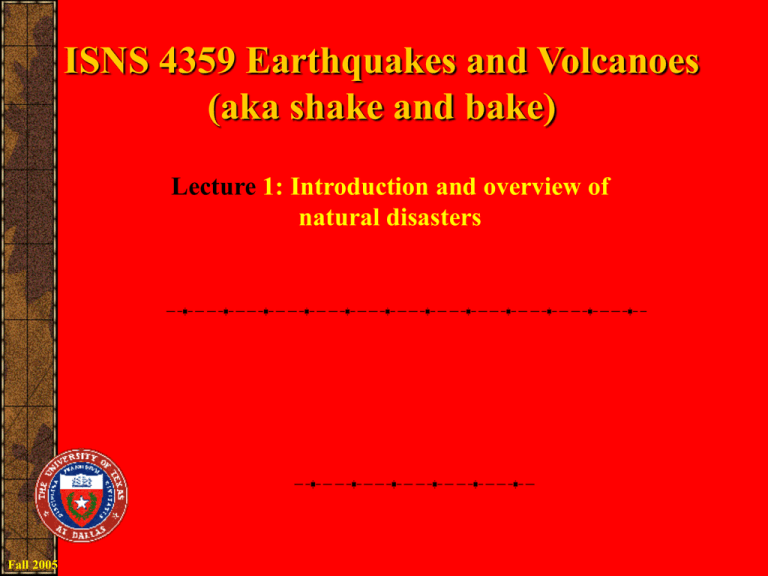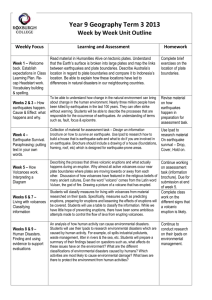Lecture 1: Introduction and overview of natural disasters
advertisement

ISNS 4359 Earthquakes and Volcanoes (aka shake and bake) Lecture 1: Introduction and overview of natural disasters Fall 2005 Logistics - description Seismicity and volcanism are important expressions of earth processes shape the planet and affect humankind in both beneficial and adverse ways. Volcanoes fascinate us with their apparently calm majestic peaks potential power for calamitous destruction. Volcanoes and earthquakes can induce great floods of mud and massive tsunami , crush and bury cities, even degrade global climate. Description Volcanoes are also benevolent, ultimately the source for much of the water in our oceans and lakes, the air we breathe, fertile soil for growing coffee and vineyards, new land in tropical paradise settings, renewable geothermal and hydroelectric power, building materials, gems, metals, ski slopes, and scenic beauty. Description This course provides a broad overview of the science behind earthquakes and volcanoes, new insights about the architecture, processes, and evolution of the earth their impact on humankind and other organisms. The plate tectonics model provides the central framework in which the many aspects of earthquakes and volcanoes are described. Logistics - scope This course provides a description of relevant natural phenomena, impacting the world’s cultures observation methods, quantification measures, causes, models, theories, hazards, prediction, Logistics - scope There are two 75 minute-long lectures per week with as active student discussion as possible, supplemented by rocks, physical examples, web resources, DVD videos, and computer projected images. Graded assignments include problem sets, a current event journal, and three tests and 5 pop quizzes.. Logistics - objectives The main goals of this class to increase awareness develop an appreciation of the role of earthquakes and volcanoes in our lives provide a framework and explanation of these natural phenomena, basic information to assist the student in making well-informed, safe, and wise lifedecisions. Other desired objectives will also be considered. Logistics - details Instructor: Dr. Carlos Aiken Phone: 972-883-2450 Office: FO 2.224A E-mail: aiken@utdallas.edu Textbook: Natural Disasters by Patrick Abbott (2006, 5th edition, though you can also get the older 4th edition, 2004). Published by McGraw Hill. I have ordered the book at the on-campus bookstore and at OffCampus Books. However, it may be cheaper through Amazon.com ($83.13). Logistics - participation Class Attendance & Participation: Attending class and actively participating in it are highly recommended. Short (5-10 min) quizzes will be given at the beginning of five random class meetings to provide extra credit, and motivate attending class and reading the textbook (no make-ups). Class participation includes asking intelligent questions during the Q&A portion of lectures or on the WebCT discussion page, and contributing current events and humorous items related to earthquakes and volcanoes in the news. Reading assignments: Textbook readings are intended for study before class; lectures will be given assuming a certain level of background and familiarity. Readings and lectures do not necessarily cover identical materials; they are intended to complement each other. The short quizzes will be taken from previous lecture materials. Other book, journal, web and electronic resources can be found on the links in the course WebCT homepage. Course content includes the textbook and lecture materials. Handouts will be provided after each class through WebCT to summarize class content and to fill any textbook gaps. Logistics - assessment Problem Sets: Due by the end of class on the due date. No credit for late assignments, unless special prior arrangements have been made with the instructor. Two Journals (I & II) will be due by the end of class on dates in the syllabus. Journals will deal with descriptions of 1 current earthquake or volcano event per week over a 4 week period (including sketch maps and cross sections describing the plate tectonic framework), following the assigned format. Tests: Test materials will be taken both from the textbook (see discussion in syllabus below), handouts, and lectures. Tests will include ~50 multiple choice, fill in the blank, T/F, sketch/diagram, or short answer questions. A pre-test review will take place during the class meeting prior to the test. Tests will be reviewed in class approximately one week after they are given. Test Make-up: Tests will not be taken at any time except during the scheduled inclass period, unless the instructor agrees to reschedule an individual's test as the result of a prior agreement, or a doctor's excuse certifies the student was too ill to attend class the day of the examination. If you have health problems, or extenuating circumstances, please contact the instructor as soon as possible so arrangements can be made. Logistics - assessment Grading: You can keep track of your grades by checking the course WebCT page (link available on the UTD homepage or webct.utdallas.edu). The final grade is based on the following percentile divisions A+: 97.1-100; A: 93.1-97; A-: 90.1-93; B+: 87.1-90; B: 83.1-87; B-: 80.1-83; C+: 77.1-80; C: 73.1-77; C: 70.1-73, D=60.1-70, F<60. Short pop quizzes will be given in 5 random class meetings and will serve as extra credit opportunities. Logistics - assessment Grading components: (total 600 points) 3 tests, 100 points each “Journals” (75 pts each) 2 Problem Sets, 25 points each Class participation Extra Credit 5 pop quizzes 300 150 100 50 50 (100%) (50%) (25%) ( 12%) ( 6%) (up to +6%) Logistics - your instructor • I have been a geologist and a geophysicist •work on potential fields (gravity and magnetics, electrical methods) applied to resources, ground water, engineering • Also in another life time was a seismologist, assistant to State of Washington Seismologist • Have been in many earthquakes, some famous (Seattle ’56,’66; Alaska ’64; Parkfield, CA ’66). Now I build 3D virtual photo real models of geology Overview of Natural Disasters 2003 Natural Disasters More than 83,000 people killed by natural disasters in 2003 Bam, Iran earthquake: 41,000 people Gujarat, India (2001): 20,000 people Izmit, Turkey (1999): 19,000 people Tangshan, China (1976): 240,000 people European heat wave: more than 35,000 people Unique event Unprecedented temperatures, but probably more frequent with global warming Human Fatalities in Natural Disasters Sawtooth-shaped curve caused by largest natural disasters Biggest killers (in order): hurricanes, earthquakes, floods, severe weather, landslides, volcanic eruptions, tornadoes and tsunami Most mega-killer disasters occur in densely populated belt through Asia, along Indian Ocean – number of fatalities is proportional to density of population Effects on survivors Increase in suicides Increase in altruism Economic Losses from Natural Disasters Destruction and damage to structures, loss of productivity and wages Increase in economic losses over time is result of increase in human population and urbanization Most expensive events caused by storms and occurred in U.S., Europe and Japan Natural Hazards Hazard exists even where disasters are infrequent Evaluate site risk Mitigation prior to event Engineering, physical, social and political plans and actions to reduce death and destruction from natural hazards Mitigation after event Rebuilding and re-inhabiting same site Case history: Popocatepetl Volcano, Mexico • Eruptions in 822, 1519 and beginning again in 1994 • Currently 100,000 people living at base Magnitude, Frequency, and Return Period Inverse correlation between frequency (how often it occurs) and magnitude (how big it is) of a process Frequent occurrences are low in magnitude, rare occurrences are high in magnitude Small-scale activity is common, big events are rare Larger the event, longer the return-period (recurrence interval) Cost-benefit ratio can be considered in conjunction with return-period of given magnitude event The 20th Century Was Unique Population growth at unprecedented and breathtaking rate, doubling twice Increased numbers of people in hazardous settings Overview of Human Population History Difficult to assess early human population growth Human species ‘began’ approximately 160,000 years ago, with a few thousand people Human population grew to 6.3 billion people in 2003 Growth rate is exponential IN THE 20th CENTURY Population growth at unprecedented and breathtaking rate, doubling twice Increased numbers of people in hazardous settings The Power of an Exponent of Growth Visualize in terms of doubling time Number of years for population to double in size, given annual percentage growth rate Doubling time = 70 % growth rate/year Example of interest paid on money • Linear growth: $1000 + $100 / year • Exponential growth: $1000 + 7% / year Example of water lily plant in pond • Doubles in size every day • Covers half the pond the day before it covers the whole pond The Last 10,000 Years of Human History Flat population growth curve until 8,000 years ago Agriculture established Domestication of animals Growth rate increased to 0.036%/year By 2,000 years ago, population ~200 million people Better shelter, food and water supplies faster population growth Growth rate of 0.056%/year By 1750, population ~800 million people The Last 10,000 Years of Human History By 1750, population ~800 million people Establishment of public health principles, causes of disease recognized Birth rates soared, death rates dropped By 1810, population ~1 billion By 1925, population ~2 billion By 1960, population ~3 billion By 1974, population ~4 billion By 1987, population ~5 billion By 1999, population ~6 billion By 2012, projected population ~7 billion The Human Population Today Present population: (insert number) Growth rate = 1.3%/year Doubling time = 53 years Growth rate = fertility (birth) rate – mortality (death) rate Future World Population Demographic transition theory: Mortality and fertility rates decline from high to low levels because of economic and social development Population Reference Bureau estimates world population growth rates are dropping From 1.8% in 1990 to 1.3% in 2003 Due to urbanization and increased opportunities for women Future World Population BUT population explosion continues From 1950 to 2000 population grew from 2.5 billion to 6 billion Growth rate of 1.3%/year means population of 9 billion in 2050 Consider no. of births / woman to predict 2150 population Average 1.6 children/woman: 3.6 billion Average 2 children/woman: 10.8 billion Average 2.6 children/woman (current average): 27 billion Mathematical Extrapolation Too many people? Crowding in cities Crime Pollution Illegal migration Disease Room for more people? Entire world population could fit inside 42 km x 42 km square Consider carrying capacity Carrying Capacity How many people can Earth support? Calculations of carrying capacity vary considerably Increasing amounts of food can be produced People can migrate from areas of famine or poverty to less crowded or wealthier areas BUT Earth’s resources are finite, so solutions are temporary








